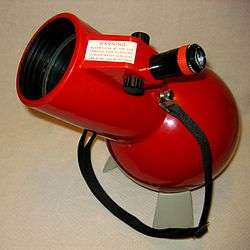Astroscan

The Astroscan is a wide-field Newtonian reflector telescope produced by the Edmund Scientific Corporation. It was designed by Norman Sperling and Mike Simmons to be used as an introductory telescope.[1] Rather than using a more traditional equatorial or altazimuth mount the Astroscan features a spherical housing around the primary reflector which sits in a cast aluminum cradle. The design is durable and allows for simple operation by novice amateur astronomers; it won an Industrial Design Award in 1976.[2] The telescope body is made from high impact ABS and is equipped with a carrying strap to aid portability.
Optical design
The Astroscan is a simple Newtonian reflector. It has a 4⅛" clear-inch (105mm) diameter f/4.2 aluminized and overcoated borosilicate glass parabolic primary mirror with a focal length of 17½ inches (445mm).[2] Because it is targeted at the novice market the telescope does have its limitations: The general design is for low power hand-held or wide-angle work, the short f/4 focal ratio does not allow for high magnification without the image degrading,[3] and the primary mirror is factory aligned with no provisions for adjustment. The telescope's secondary mirror is mounted on an optical window at the front of the tube, giving it the appearance of a catadioptric telescope, but the window is flat and does not contribute to the focal properties of the telescope. The Astroscan comes with 15 mm and 28 mm focal length Plössl eyepieces, giving it a magnification of 30X and 16X respectively, with a 3.0° field of view using the 28 mm eyepiece, and a 1.6° with the 15 mm.[2]
The name
When Edmund Scientific introduced the telescope in 1976 they called it "The Edmund Wide-Field Telescope" with a Part Number "2001"[4] Edmund had a public contest which ran until November 15, 1976 to come up with a name.[5] The winning name was "Astroscan 2001". The "2001" part of the name has been dropped over time.
See also
External links
- A guide to cleaning the Astroscan's optical window
- Review of the Astroscan "Edmund Scientific Astroscan telescope" from 30 April 2004
- Astroscan Memories by Norman Sperling, January 15, 2011
References
- ↑ "Astroscan Memories". Everything in the Universe.
- 1 2 3 "Edmund Scientific: Astroscan Telescope". Edmund Scientific Corporation.
- ↑ Harrington, Phillip S. (2002). Star Ware: The Amateur Astronomer's Ultimate Guide to Choosing, Buying, and Using Telescopes and Accessories. John Wiley and Sons. p. 116. ISBN 0-471-41806-4.
- ↑ Edmund Wide-Field Telescope manual, published September 1976, Edmund Scientific Company, Barrington NJ, CLOUDY NIGHTS FORUM ARCHIVES, Equipment Discussions >> Classic Telescopes, Edmund Scientific 4.25" WF Pre-Astroscan Serial #? catalog images
- ↑ Piers Anthony, How Precious Was That While, Macmillan - 2002, page 372